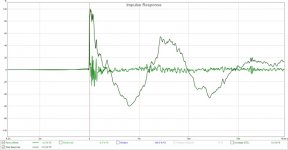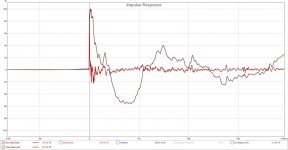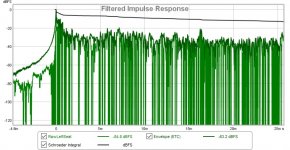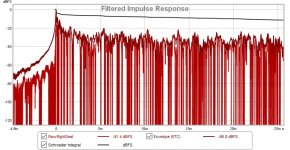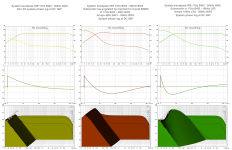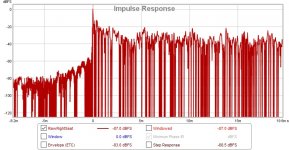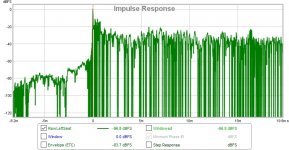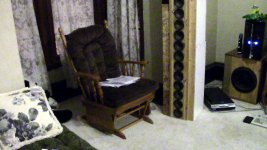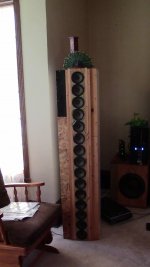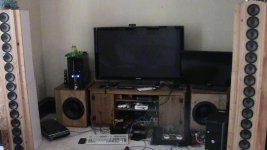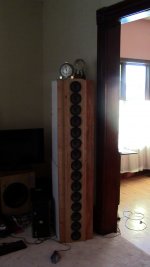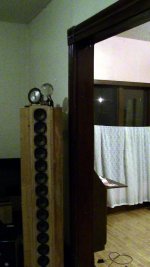The arrays are unlikely to have any directivity for wavelengths that are much larger than the dimension of the arrays. So, it would follow the 6db/double distance drop in SPL, the same as a normal woofer. The distance v SPL measurements are somewhere in my thread. I recall the directivity benefit stopped near 160 Hz, very closely corresponding to the length of the array.
Hahaha, bushmeister, I've made those same calculations. If funds were not a problem I'd be all over it, just for HT use would make it worth it.
I do have output at 17 Hz, but don't expect to be able to do a full blow there, not with this amp anyway. I've had a higher cut off frequency starting to drop at 35 Hz. I started missing the feel parts within certain songs. It brings so much atmosphere, so that's why I'd want a more long term solution for the bottom end.
My thoughts are just as yours, have the subs + lines work together to be able to restrict the output on the low end of the arrays, and have the subs do the heavy lifting.
That bottom octave is too much fun to let go off, that's what I learned. It's a mood thing, they can push up the pressure you feel.
A good test song for that is "A Perfect Circle" - "Lullaby". This song borders on being playable even though the low end is ~25 Hz. But if you have it set so nothing blows, the mood presented by that low end pressure is awesome!
I do have output at 17 Hz, but don't expect to be able to do a full blow there, not with this amp anyway. I've had a higher cut off frequency starting to drop at 35 Hz. I started missing the feel parts within certain songs. It brings so much atmosphere, so that's why I'd want a more long term solution for the bottom end.
My thoughts are just as yours, have the subs + lines work together to be able to restrict the output on the low end of the arrays, and have the subs do the heavy lifting.
That bottom octave is too much fun to let go off, that's what I learned. It's a mood thing, they can push up the pressure you feel.
A good test song for that is "A Perfect Circle" - "Lullaby". This song borders on being playable even though the low end is ~25 Hz. But if you have it set so nothing blows, the mood presented by that low end pressure is awesome!
20ms STEPS in %
Thanks Brytt, I am still slowly learning this software and how to use these graphs to improve the sound.
These look a lot better, a broad peak between about 5ms to 10 ms, centered at 7 ms. At the speed of sound, 7 ms is about 9 feet, which is the distance of the arrays to my back wall. Not sure what is causing the 11 ms peak from the right speaker, that is about 14 feet - outside this room. Maybe that open doorway is not benefiting me as much as I thought. Do I have the math of this concept right?
Edit: Maybe the 11 ms peak is caused by the right array bouncing off the left back side wall/corner. This does not occur on the Left array due to the open door... thinking aloud here...
Thanks Brytt, I am still slowly learning this software and how to use these graphs to improve the sound.
These look a lot better, a broad peak between about 5ms to 10 ms, centered at 7 ms. At the speed of sound, 7 ms is about 9 feet, which is the distance of the arrays to my back wall. Not sure what is causing the 11 ms peak from the right speaker, that is about 14 feet - outside this room. Maybe that open doorway is not benefiting me as much as I thought. Do I have the math of this concept right?
Edit: Maybe the 11 ms peak is caused by the right array bouncing off the left back side wall/corner. This does not occur on the Left array due to the open door... thinking aloud here...
Attachments
Last edited:
Hi Allen, we can see a couple of things here. Though it would help to also see the same area in the filtered IR. Just to see what level some of those disruptions are. Several things can influence the behaviour of the STEP. Not only reflections (I see a couple of very early ones) but also the driver itself. Also the length of the array matters, as it will end behaving as a directive source at some point as mentioned above.
The filtered IR tab should look something like this:

This is in dBFS. It shows the levels of the reflections. My goal has been to get everything in the first 20 ms down by -20 dB right after the peak. This isn't totally fair, as it does not show the complete picture. The low end isn't that good presented in this graph. But for starters it would be a good goal. I know this graph shows a way longer time frame, the first 20 ms would be enough to concentrate on for this moment. Getting that cleaner will also clean up the slowly declining tail.
A third graph that is useful to see next to the two above is the frequency plot with phase, with a ~5 cycle frequency dependent window. Just to see where phase is moving off from the normal expected path. (another indication of trouble, either due to the drivers/enclosure/room. At those points where phase is showing a change in direction the STEP could also sway the other way.
The filtered IR tab should look something like this:

This is in dBFS. It shows the levels of the reflections. My goal has been to get everything in the first 20 ms down by -20 dB right after the peak. This isn't totally fair, as it does not show the complete picture. The low end isn't that good presented in this graph. But for starters it would be a good goal. I know this graph shows a way longer time frame, the first 20 ms would be enough to concentrate on for this moment. Getting that cleaner will also clean up the slowly declining tail.
A third graph that is useful to see next to the two above is the frequency plot with phase, with a ~5 cycle frequency dependent window. Just to see where phase is moving off from the normal expected path. (another indication of trouble, either due to the drivers/enclosure/room. At those points where phase is showing a change in direction the STEP could also sway the other way.
Last edited:
Hahaha, bushmeister, I've made those same calculations. If funds were not a problem I'd be all over it, just for HT use would make it worth it.
I do have output at 17 Hz, but don't expect to be able to do a full blow there, not with this amp anyway. I've had a higher cut off frequency starting to drop at 35 Hz. I started missing the feel parts within certain songs. It brings so much atmosphere, so that's why I'd want a more long term solution for the bottom end.
My thoughts are just as yours, have the subs + lines work together to be able to restrict the output on the low end of the arrays, and have the subs do the heavy lifting.
That bottom octave is too much fun to let go off, that's what I learned. It's a mood thing, they can push up the pressure you feel.
A good test song for that is "A Perfect Circle" - "Lullaby". This song borders on being playable even though the low end is ~25 Hz. But if you have it set so nothing blows, the mood presented by that low end pressure is awesome!
We are completely on the same wavelength (sorry for bad pun).
Sub bass is the atmosphere in my book, given your line arrays, I will look forward to the time funds allow you to build your sub's! I will be eagarly watching to see what you come.up with!
Filtered IR in dBs
Here they are, scaled to match the STEP. The arrays are 60" (152.4 cm) tall, so I am in the near field down to about 600 Hz in my listening area. Also, the drivers have a rim that sticks out, and the cabinet baffles are not smooth. It would be good to learn how to see this in these graphs, so when I start designing my Vifa arrays, I can "see" what is going on and connect that to what I am hearing. 🙂
Here they are, scaled to match the STEP. The arrays are 60" (152.4 cm) tall, so I am in the near field down to about 600 Hz in my listening area. Also, the drivers have a rim that sticks out, and the cabinet baffles are not smooth. It would be good to learn how to see this in these graphs, so when I start designing my Vifa arrays, I can "see" what is going on and connect that to what I am hearing. 🙂
Attachments
The thing I notice, both in the IR and these filtered IR's is the stuff that happens right after the peak in the first ms. Those are also the points where you clearly go above that -20 dB goal for now. The right array is doing something the left isn't showing at 2 ms. But it's less busy in that first millisecond. Can we learn something from that by observing the surroundings of the arrays?
Wait a minute, the left has that too, only at a lower level. See how both have an upwards peak at 2ms?
How are they placed, distance to back wall from baffle, how near are side walls to the arrays etc. Pictures do help.
Another thing to note. You won't see any direction in this graph, so always look around the mic for reflective surfaces as well.
Wait a minute, the left has that too, only at a lower level. See how both have an upwards peak at 2ms?
How are they placed, distance to back wall from baffle, how near are side walls to the arrays etc. Pictures do help.
Another thing to note. You won't see any direction in this graph, so always look around the mic for reflective surfaces as well.
Last edited:
Can you supply us with the RAW IR's of the left and right channel? Stuff that happens very early can sometimes be corrected with DRC (see the DRC manual about placement).
We are completely on the same wavelength (sorry for bad pun).
Sub bass is the atmosphere in my book, given your line arrays, I will look forward to the time funds allow you to build your sub's! I will be eagarly watching to see what you come.up with!
You made me look for the 12" XXLS data sheet again 😱 But the current foot rests are only 37 x37 x 35 cm (outside measurements). They do have a remarkable flat FR making a nice transition possible with the arrays.
Now I really hate the fact my wallet is empty...
It should work though, even in that small of a box. I remember I've looked at it at one point, long ago.
Last edited:
Thanks Brytt, I am still slowly learning this software and how to use these graphs to improve the sound...
Great and welcome guess your arrays has subwwofer that includes IRR XO as in right examples of simulation based on IR created in Rephase.
At left is close to as wesayso's arrays, in middle same with a subwoofer IRR XO'ed at very low frq as mayhem13 suggested to be sub LP 2.order and arrays HP 1. order, and at right is also with sub but at 100Hz symmetric LR 2.order. Step response in first differ from wesayso's real world probably mostly because of his preferred ala B&K tonal house curve so that top of peak get rounded pretty much. Phase turn from IRR XO to filter subwoofer into picture is the difference that change SR and waterfalls by the way at waterfalls we look 20dB down, and at 100Hz LR2 we see otherwise the left one how it phase starts go lagging numbers around 2kHz and muds up in midrange area if i'm right : )
Of course if FIR power is available and CPU process release time to correct phase is accepted then middle and right example can look and sound have exactly same SR and waterfall as left one.
Attachments
Last edited:
Wesayso,
A day or two ago you recommended "Lullaby"...as a good test song. I just listened to that song with my TC9FD Tabaq's, supported with a 12" sealed sub...oh my, a rather haunting lullaby and quite a window rattler! 🙂
A day or two ago you recommended "Lullaby"...as a good test song. I just listened to that song with my TC9FD Tabaq's, supported with a 12" sealed sub...oh my, a rather haunting lullaby and quite a window rattler! 🙂
I'm curious as to why all the talk about adding subs to this system. If the in-room F3 is 17 Hz, there is no lack of low end extension. Is it an xmax and SPL limit that's the worry? Or distortion in the bottom end? I have not studied the distortion plots, so am curious.
One part of the issue is that the bottom end is EQ'd up and any increase in the very low end such most amps dry fast. It require mucho power to increase low end SPL.
An early plot from mine:
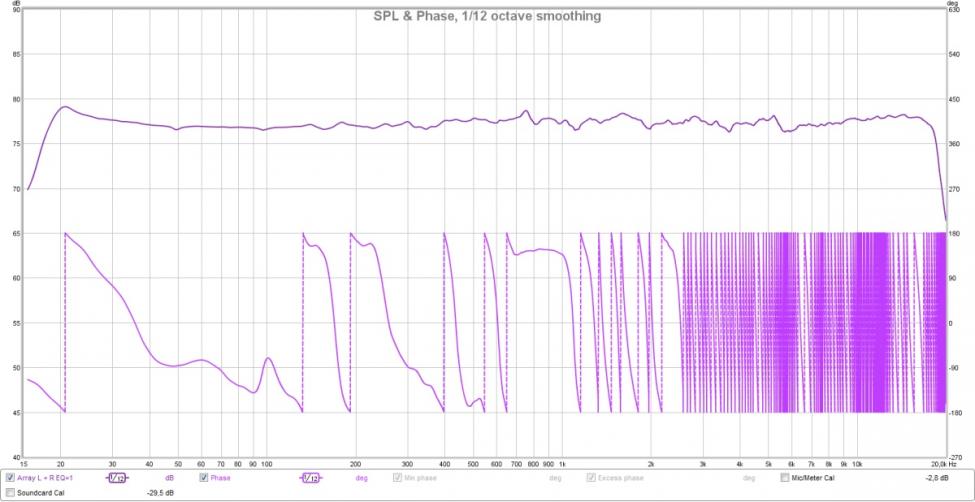
An early plot from mine:

I'm curious as to why all the talk about adding subs to this system. If the in-room F3 is 17 Hz, there is no lack of low end extension. Is it an xmax and SPL limit that's the worry? Or distortion in the bottom end? I have not studied the distortion plots, so am curious.
Prob not a huge issue for civilized music listening at reasonably low levels.
The in-room F3 is 17 hz - but if you read my post you will see the line arrays have a VD (volume displacement - which is the all important number when producing sub-bass) of 555cm3. This is comparable to a pair of 'normal' floor standing speakers with a couple 8" drivers per side, or perhaps one 10" woofer per side.
However, if you are a visitor to any home theatre websites, or aware of THX standards for sub-bass reproduction, particularly for movies, you will know that 555cm3 will only get you about 92bB at 17 hz at 1M, and only about 82dB at 3M listening distance - fully x-max'ed out.
This is obviously well short of THX standards and the reason why the 'subwoofer' was invented!
This discussion came about after talking about how important proper bass reproduction was to listening to music (and of course movies) as the sub bass really recreates the 'atmosphere' - IMHO reaching down to at least 20hz with decent levels is really important to realism - particularly for live recordings.
I hope wesayso eventually has the funds to sort out some distributed subs, because I run 4 x 10" small sealed subs in conjunction with my 3-way speakers (which have 8" woofers) and since adding them I haven't looked back. The difference is that it recreates the large venue to have all the sub-bass accurately reproduced underpinning it all.
YMMV🙂
Wesayso,
A day or two ago you recommended "Lullaby"...as a good test song. I just listened to that song with my TC9FD Tabaq's, supported with a 12" sealed sub...oh my, a rather haunting lullaby and quite a window rattler! 🙂
Parts of it are from: Counting Bodies Like Sheep To The Rhythm Of The War Drums from the EP emotive. Also a marvellous song but less demanding down low. The cover of "When The Levee Breaks" on that EP is also a fun track.
That lullaby does give the low end a work out!
I'm curious as to why all the talk about adding subs to this system. If the in-room F3 is 17 Hz, there is no lack of low end extension. Is it an xmax and SPL limit that's the worry? Or distortion in the bottom end? I have not studied the distortion plots, so am curious.
For music, I don't think I need it, except it might be a good idea to have some headroom. I have to really take care of my digital chain to avoid clipping (digitally) on tracks like Lullaby.
The next weak link is my amplifier. It's rated at a 100 watt into 8 ohm. Which means I can't hit notes full force at 17 Hz, or even 20 Hz for that matter. They don't happen all that often in music. But they do use it in movies. When I play a movie, the sub channel is mixed into my mains by JRiver as I don't have a separate sub. Once a broad band signal is asked of my arrays that contains a lot of low frequency I will run out of usable excursion quickly. I will run out of amplifier power first though.
Let's look at that Lullaby track:

The loudest notes are at ~37 Hz. Put there's still pumping bass at 25 Hz. When the drivers have to do those two notes simultaneously, they will work harder than on one single note. But get it right and that low end pressure is marvellous. I could play this song without running into trouble. But the first time I played it I had to make a few tweaks because I ran into nasty sounding digital clipping. Even after running JRiver's analyser tool to prevent clipping.
Because the notes at 25 Hz aren't clipping. But they do pump.
Lets see a graph of a "simple" song, I never had any problem playing it, but I did notice differences between 2 different masters of that same song:

Guess where that difference is... This is "Bird on a Wire" by the way, from Jennifer Warnes.
At first I only looked at 20 Hz to 20 KHz, never really did mind what happened below 20 Hz. But after literally seeing my cones move without hearing much I became aware that I'd better take care of incorporating a nice roll off below 20 Hz. You never know what might hit you.
On a lot of material there is quite a bit of low rumble. Never really noticed it before on other speakers. But the songs that have it set a mood that's unmatched by the more clean productions. Some may have it intentionally, old songs sometimes had it because they didn't notice.
Like Etta James - I Just Want To Make Love To You. There isn't any danger of clipping here (at least not for me), but the mic isn't cut off on the low end and you hear that bump from time to time when the stand gets hit. I love that! This one should be obvious on most systems. It still has something extra for those that run that low end all the way down.

See there's still peaks at 30 Hz and 20 Hz?
So why do I consider adding subs? Piece of mind really, and headroom. But I don't want to miss all that low end fun. Its on more tracks than I ever knew. Now that I know what it can do, I don't want to be without it anymore.
Here's where the 17 Hz figure comes from:

This is how my EQ is set. Notice a roll off at the low end. I have made the mistake of not looking at that roll off carefully enough.
Hope Mayuri doesn't mind but I will take his graph as an example:
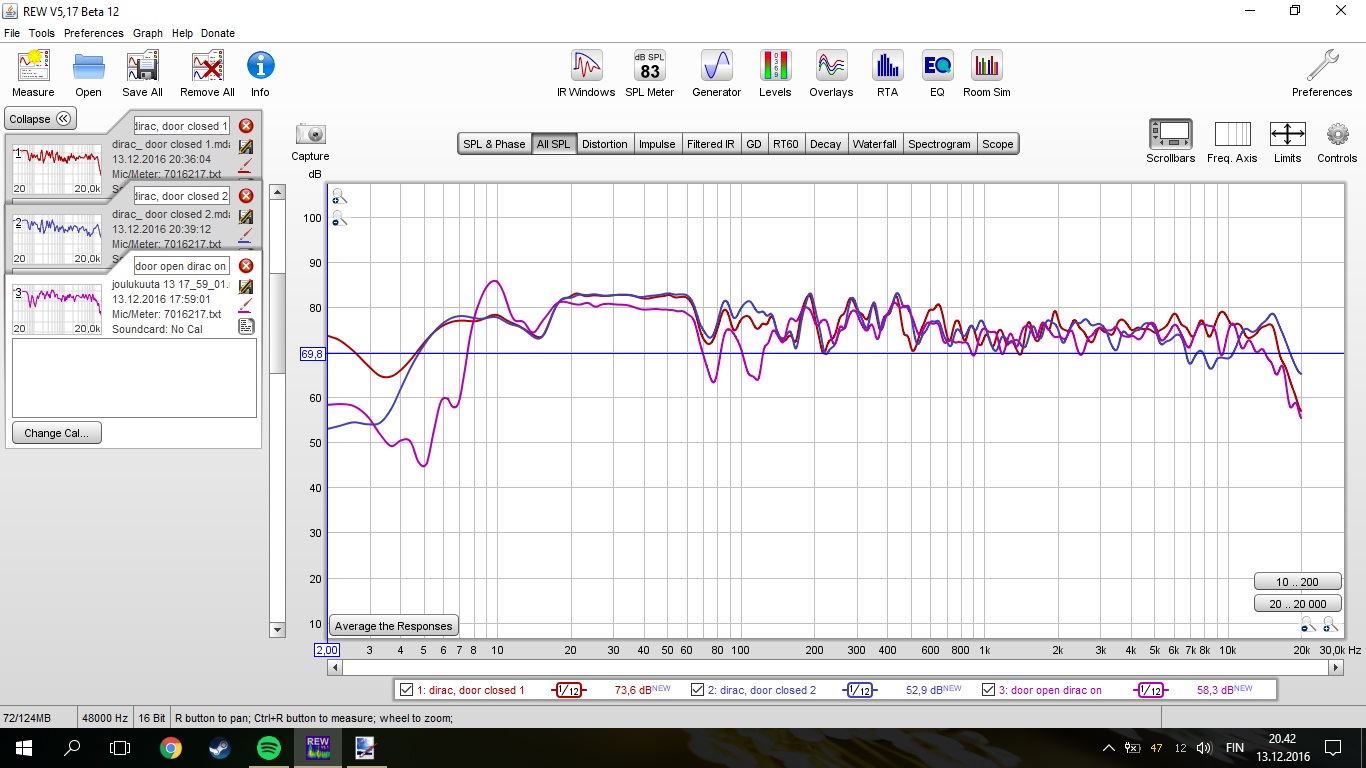
See how the EQ is set? With a big bump at 10 Hz? On ~98% of recordings he will be fine. But I bet he will get a scare sooner or later if he keeps that graph like this. Listen at 88 dB to 92 dB average and all of a sudden you think: what was that! Especially if he leaves the door open 😀.
Last edited:
One part of the issue is that the bottom end is EQ'd up and any increase in the very low end such most amps dry fast. It require mucho power to increase low end SPL.
An early plot from mine:

Indeed it does need a lot of power. And care in the gain setup. Do you still run as flat a frequency curve? If I do that it will rip my head off being so bright.
As is obvious I run about an almost 10 dB decline from low to high. The sides are EQ-ed a tiny bit different, but not much.
I also suspect by making the time alignment more strict, it strains the low end even more as all of the notes combined make more movement of the cones if they do line up.
Last edited:
No, this was just an early sweep related to the low end possibility of the arrays when I was aiming for "ideal" response. I suspect a sweep now would give me different reading 🙂
Just tried lullaby again, it plays fine but now I remember why I didn't add it to my library like the rest of the songs. All of my songs are analysed by JRiver to play them back at a reference level. If I just play the track from disk it isn't keeping the analyse data.
That means it plays at a standard -10 dB level. No problem there, it can handle it even louder. As soon as I run the analyser it wants to run it at a -2.9 dB level. At that level I will experience massive digital clipping due to my EQ scheme. Somehow the analyser isn't detecting the higher than normal low end. One of very few tracks that I have to take good care of. At -10 dB the low end build up is obvious, my cones are hardly moving at all. A digital problem, so to speak.
In contrast "When the Levee Breaks" is analysed by JRiver to play at -12.4 dB and plays flawlessly. Nice atmosphere on that one.

That means it plays at a standard -10 dB level. No problem there, it can handle it even louder. As soon as I run the analyser it wants to run it at a -2.9 dB level. At that level I will experience massive digital clipping due to my EQ scheme. Somehow the analyser isn't detecting the higher than normal low end. One of very few tracks that I have to take good care of. At -10 dB the low end build up is obvious, my cones are hardly moving at all. A digital problem, so to speak.
In contrast "When the Levee Breaks" is analysed by JRiver to play at -12.4 dB and plays flawlessly. Nice atmosphere on that one.

Last edited:
Clarification
I am using subs at the moment, with IIR XO and time alignment. But they are not included in the measurements I have been showing in these recent posts. In fact, these measurements are my arrays with no processing or subs...
Lately, my audio journey has been toggling different EQ settings in PEQ, REW's EQ wizard and re-phase. Before I upgraded my Amp and DAC, I preferred doing everything linear phase in re-phase, but now with my new toys, I found those settings "over-processed". I am relearning this stuff, because it all sounds different now. So now I prefer minimum phase EQ. I exported a WAV filter file I really liked from the EQ wizard in REW and have not figured out why I like it better then the same settings in JRiver's PEQ. I want to recreate it in Re-phase, so I can put my cross-over phase correction back in. My gut is telling me it has something to do with the "windowing" settings: like "rectangular", "hamming", "blackman" etc...
Out of curiosity, this led me to try DRCDesigner. As I mentioned many posts back, my attempt was not successful. But as Wesayso pointed out, the windowing (not to be mistaken for the "windowing" in re-phase) on the presets is too long, so I need to use the custom settings. But I wanted to see what I could fix physically in my room first, hence the recent measurements. Once I get a good handle on how to use these measurements, I would hope I can get it all working together. I have found personally, that time alignment is the thing to get right. I like what phase correction does for cross-overs also, and I hope to be able to "see" this in these IR's as is does not show on the FR, even thou I can hear a difference. 😉
As requested, here are the "regular" IR's in dBfs:
Great and welcome guess your arrays has subwwofer that includes IRR XO as in right examples of simulation based on IR created in Rephase.
I am using subs at the moment, with IIR XO and time alignment. But they are not included in the measurements I have been showing in these recent posts. In fact, these measurements are my arrays with no processing or subs...
Lately, my audio journey has been toggling different EQ settings in PEQ, REW's EQ wizard and re-phase. Before I upgraded my Amp and DAC, I preferred doing everything linear phase in re-phase, but now with my new toys, I found those settings "over-processed". I am relearning this stuff, because it all sounds different now. So now I prefer minimum phase EQ. I exported a WAV filter file I really liked from the EQ wizard in REW and have not figured out why I like it better then the same settings in JRiver's PEQ. I want to recreate it in Re-phase, so I can put my cross-over phase correction back in. My gut is telling me it has something to do with the "windowing" settings: like "rectangular", "hamming", "blackman" etc...
Out of curiosity, this led me to try DRCDesigner. As I mentioned many posts back, my attempt was not successful. But as Wesayso pointed out, the windowing (not to be mistaken for the "windowing" in re-phase) on the presets is too long, so I need to use the custom settings. But I wanted to see what I could fix physically in my room first, hence the recent measurements. Once I get a good handle on how to use these measurements, I would hope I can get it all working together. I have found personally, that time alignment is the thing to get right. I like what phase correction does for cross-overs also, and I hope to be able to "see" this in these IR's as is does not show on the FR, even thou I can hear a difference. 😉
As requested, here are the "regular" IR's in dBfs:
Attachments
Pictures of a work in progress...
I am a little embarrassed to show these, partly due to the mess my system is in and the build quality of these cabinets. But the more I can learn and get out of this "Cheap and Cheerful" system, the better my next build will be. The amazing thing is how much Joy this hack of a system has given me. 🙂
2ms is about 28". The front panel of the arrays is 3 feet in front of the subs and entertainment center, so I do not think that peak is caused by that or the TVs. I am thinking it might be the rocking chair for theleft array, as the back cushion is about 28" from the array. This might explain why the peak is softer from that speaker, as the cushion absorbs. (Apparently it reflects too 😱) For the Right array, the only thing at 28" on the front side of the speaker is the top of the archway. With the arrays being 60" tall, the reflecting frequency would be below 225 Hz, at least in theory. In both cases, it could be the side walls behind the speakers also. I could try moving the rocking chair and remeasure that channel to "see".
For some of the closer hash I have, I am wondering if the archway side is influencing the Right speaker. For sure, the baffle and the driver ridge is causing some of this. I have considered mounting the drivers on the inside of the baffle, so the baffle sticks out slightly above the ridge. I could then figure out a way to do a round over. Also, I could make these cabinets way smaller. Yet that valuable time could be spent building the Vifa Array too. We will see, if I learn something by improving these "Cheerfuls", it would just make the Vifa build that much better.
I am a little embarrassed to show these, partly due to the mess my system is in and the build quality of these cabinets. But the more I can learn and get out of this "Cheap and Cheerful" system, the better my next build will be. The amazing thing is how much Joy this hack of a system has given me. 🙂
2ms is about 28". The front panel of the arrays is 3 feet in front of the subs and entertainment center, so I do not think that peak is caused by that or the TVs. I am thinking it might be the rocking chair for theleft array, as the back cushion is about 28" from the array. This might explain why the peak is softer from that speaker, as the cushion absorbs. (Apparently it reflects too 😱) For the Right array, the only thing at 28" on the front side of the speaker is the top of the archway. With the arrays being 60" tall, the reflecting frequency would be below 225 Hz, at least in theory. In both cases, it could be the side walls behind the speakers also. I could try moving the rocking chair and remeasure that channel to "see".
For some of the closer hash I have, I am wondering if the archway side is influencing the Right speaker. For sure, the baffle and the driver ridge is causing some of this. I have considered mounting the drivers on the inside of the baffle, so the baffle sticks out slightly above the ridge. I could then figure out a way to do a round over. Also, I could make these cabinets way smaller. Yet that valuable time could be spent building the Vifa Array too. We will see, if I learn something by improving these "Cheerfuls", it would just make the Vifa build that much better.
Attachments
- Home
- Loudspeakers
- Full Range
- The making of: The Two Towers (a 25 driver Full Range line array)
